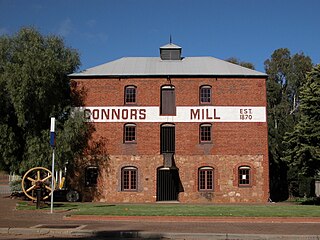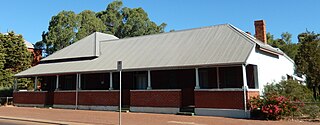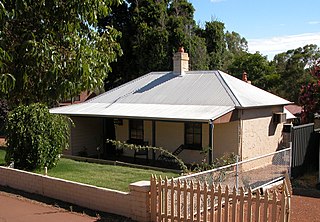
Toodyay, known as Newcastle between 1860 and 1910, is a town on the Avon River in the Wheatbelt region of Western Australia, 85 kilometres (53 mi) north-east of Perth. The first European settlement occurred in the area in 1836. After flooding in the 1850s, the townsite was moved to its current location in the 1860s. It is connected by railway and road to Perth. During the 1860s, it was home to bushranger Moondyne Joe.

Connor's Mill is a steam driven flour mill located on Stirling Terrace in Toodyay, Western Australia.

The Newcastle Gaol Museum is a prison museum on Clinton Street in Toodyay, Western Australia, founded in 1962. The museum records the history of the serial escapee Moondyne Joe and his imprisonment in the "native cell".

Butterly House, also known as Monger's Cottage, is located at 1A-D Harper Road, Toodyay, Western Australia. The building was the location of the first bank in Toodyay.

Connor's House is a single storey dwelling in Stirling Terrace, Toodyay, Western Australia.

Stirling House is located on Stirling Terrace in Toodyay, Western Australia.

The Toodyay Post Office and residence is located in Toodyay, Western Australia on the corner of Stirling Terrace and Duke Street North.

Kirk's (Pensioner) Cottage on Stirling Terrace in Toodyay, Western Australia was built between 1852 and 1856 by convict labour.

Hackett's (Pensioner) Cottage is located on Stirling Terrace in Toodyay, Western Australia and was built around 1855 by convict labour.

Toodyay Manor on Stirling Terrace was originally the Newcastle Hotel in Toodyay, Western Australia.

James Martin's cottage is located on Stirling Terrace in Toodyay, Western Australia.

Stirling Terrace is the main street of Toodyay, Western Australia, originally called New Road until 1905.

Demasson's House and Shop is situated on Stirling Terrace in Toodyay, Western Australia.

The old Newcastle School is an historic building on Duke Street North in Toodyay, Western Australia. It was the first purpose built school in the new town site of Toodyay, and operated as a school from 1887 to 1954.

St Aloysius Convent of Mercy is a former Catholic convent located on Stirling Terrace in Toodyay, Western Australia, part of a larger site owned by the Church. This building is a part of the complex built by the Sisters of Mercy to provide accommodation and a school.

Wendouree Tearooms is located on Stirling Terrace in Toodyay, Western Australia. Several businesses have previously been located at the site, including a bakery and produce store. Over the years it has been run by various families and individuals.

West Toodyay was the original location of the town of Toodyay, Western Australia. It is situated in the Toodyay valley, 85 kilometres (53 mi) north east of Perth. The Toodyay valley, discovered by Ensign Robert Dale in 1831, was opened up for settlement in 1836. The original site for the town of Toodyay was determined in 1836 and its boundaries were finalized 1838. The first survey of the town was carried out in 1849. After several serious floods, the decision was made to move the town of Toodyay to higher ground. In 1860, the new town of Newcastle was established 3 miles (4.8 km) further upstream. Newcastle was renamed in 1910 to Toodyay, and the original site became known as West Toodyay.
William Amed Demasson, a carpenter and wheelwright by trade, was one of Toodyay's citizens who made a substantial contribution to the civic life of the town. Among the many organizations that he belonged to, he is particularly associated with the formation of a branch of the Independent Order of Oddfellows Manchester Unity in Toodyay, or Newcastle, as it was known at the time.
Angela Browne was born in County Cork, Ireland in 1884. She would later become Mother Superior at the Sisters of Mercy Convent in Toodyay, Western Australia
Charles George Ellery was an Australian bootmaker who worked for the city of Toodyay in Western Australia. Ellery was assisted for a time by his brother James, and then his daughter Constance who continued the family business after his death in 1937. His name is associated with his home, known as the Shoemaker's House, and shop, known as Ellery's Arcade. He was one of the Toodyay's civic leaders sitting on a number of boards and committees.


















